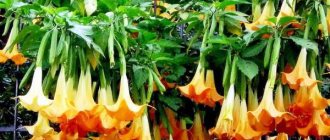- March 25, 2019
- Flowers
- Natalia Egorenkova
Summer residents come to their gardens in April and see primrose, which has hospitably opened its doors to spring with its charming key flowers. Due to its early flowering, this plant is called a primrose; its decorative value is highly valued and entire collections are bred, striking in the variety of inflorescences. There is nothing complicated in planting and caring for perennial primrose, and if you follow the basic rules of agricultural technology, the blooming beauty will greet you at your dacha every spring.
What kind of flower is primrose?
Don’t be surprised that every garden has primroses, even the simplest ones. This is exclusively our plant, which grows in temperate latitudes of the Northern Hemisphere, and is extremely rare in other climatic zones.
Primrose belongs to the Primula or Primrose family. Its closest relatives are the common loosestrife and the common loosestrife, the European seven-footed grass and the seaside milkweed. All these flowering herbs often decorate our flower beds, but few people know their biological names.
The genus Primrose includes about 400 species of mostly perennial herbs, known since ancient times, extremely popular and widely cultivated in many European countries.
The name of the plant comes from the Latin word primus, which means “first”, because the primrose blooms very early, when in some places there is still snow.
A novice gardener should definitely take up perennial primrose. Planting and care will not burden you, it blooms for a long time, and dense rosettes of decorative leaves will decorate the flower beds until frost.
What does primrose look like?
Any primrose is a low and compact plant. Together with the peduncle, its height is only 25 - 50 cm.
Despite its modest size, primrose has a highly developed fibrous root system, so the plant takes root well, and damaged ones are quickly restored.
Primrose leaves form a dense rosette. They are oval or lanceolate in shape, light green in color, sometimes with a grayish tint. The surface of the leaf is usually wrinkled, as if corrugated, strewn with barely noticeable fibers; the edges can be smooth or cut with small teeth.
The stem of the primrose, also known as the peduncle, is always bare, in many species it is long, sometimes erect or directed to the side. If proper attention was paid to planting and care when growing perennial primrose, the plant will delight you with many flower shoots.
Types and varieties of perennial primrose
The variety of primroses is enormous. Their genus includes 400 species, excluding hybrids and varieties that were developed during the work of breeders. Its lifespan, color scheme, size and shape depend on the type and variety of the plant. There are those that can withstand winter and can withstand frosts down to -40 degrees.
Ordinary
The common primrose (Primula vulgaris) is a popular species among gardeners. It is characterized by the absence of stems, multi-colored colors, and compact sizes (up to 10 cm in height). The perennial blooms from February to March. Grows in pots and flower beds. Famous varieties: “Jacpot”, “Harlequin Bicolor”, “Cobalt Blue”, “Amethyst Ice”.
Common primrose can be grown on a terrace or balcony at temperatures above -5 degrees
Ushkovaya
Primula auricula - found in meadows and calcareous rocks. The leaves of the species are collected in a mundane rosette, located on short petioles. The flowers are bell-shaped, have a pleasant aroma, and appear in April or May. Famous varieties: “Pegasus”, “Auricula”.
The auricular inflorescences smell like apricot
Julia
A variety of perennial primrose Julia (Primula Juliae) prefers to grow near bodies of water. The flowers are single, lilac in color with a yellow spot in the center. The flowering period is from April to June. Suitable varieties for the garden are: “Sylvia”, “Green Lady”.
When growing Julia, you should not overuse nitrogen fertilizers.
Large-flowered
Perennial large-flowered primrose (Primula grandiflorus) is a very popular species among summer residents. Its flowers are voluminous and come in different shades: green, purple and yellow. The most popular variety is “Francesca” with light green flowers, as well as “Selecta”, “Coco”, “Gator Stiletto”.
The flowers of the large-flowered variety are much larger than those of other species
Terry
Perennial double primrose (Terricus) - has flowers of a different palette. The plant is low and frost-resistant. The best varieties of the species are considered to be “Rosella”, “Frost”, “Rosie”.
Terry primrose tolerates Russian winters well
Mealy
Perennial powdery primrose (Primula farinosa) can grow up to 30 cm in height. Blooms with purple-pink buds from May to September. The leaves are mossy underneath and have a characteristic central vein on the surface.
Powdery primrose can be found in Eurasia and South America
Siebold
Siebold's primrose (Primula sieboldii) has elongated leaves and an elongated peduncle up to 30 cm long. It blooms for two months with buds of various flowers. Interesting varieties: Manakura, Carefree.
Sometimes Siebold is painted in two colors with stripes or eyes on the petals
High
High primrose (Primula elatior) grows up to 0.4 m. The buds are two-colored, located on hanging stems, have an orange neck and a yellow border. Based on the species, many hybrids and varieties have been bred: “Max”, “Louis”, “Suzannah”.
In the wild, tall perennial primrose is found in the Urals, the Alps and the Pyrenees
Japanese
Japanese primrose (Primula japonica) has large long leaves (25 cm) and long flowering. The inflorescences of the plant are arranged on stems in several tiers and are colored crimson. Common varieties are Apple Bloss and Alba.
Japanese primrose blooms for about 40 days
Obkonika
The perennial primrose Obconica (Primula obconica) can grow up to 30 cm. It blooms with red, white, pink buds with a green eye. It has beautiful leaves on long petioles.
Obconia reproduces well by seeds
Polyanthus
Perennial polyantha primrose (Primula polyantha) lives on average 2 years. The flowering period lasts from May to June. This species comes in a variety of colors. The buds are purple, orange, yellow and red.
Polyanthus primrose has good winter hardiness and blooms for a long time.
Rich palette of primroses
Primrose flowers consist of five petals, collected in inflorescences of various shapes: a brush, an umbrella and even a ball. One of the features of the plant is a very long flower tube formed by petals fused at the base. Therefore, do not be surprised if you rarely see bees and bumblebees on key flowers. It can be difficult for honey insects to get to the nectar.
The primrose fruit is an elongated seed capsule. However, most gardeners cut off the faded stems without waiting for the seeds to ripen, and prefer to propagate the primrose by dividing the bush.
Today, based on species diversity, many varieties of primroses with double and simple flowers, single and collected in fancy inflorescences, have been bred. Gardeners are more familiar with lilac and yellow flowers, but there are red, pink, burgundy, purple, black and snow-white primroses.
Do you know why experienced gardeners recommend growing perennial primrose? Even a novice gardener can easily cope with planting and caring in open ground.
Application in the garden
Thanks to the wide variety of color shades, using primrose you can decorate your garden in an unusually beautiful way. If desired, you can choose varieties with different flowering periods and enjoy them from April to August. Primrose looks great on alpine hills, flower beds, tree trunks, borders, bushes and around ponds. They will look beautiful next to plantings of tulips, daffodils, irises, phlox and soapwort. Species with long stems can be cut and used in bouquet arrangements.
How to grow primrose from seeds?
It’s good when neighbors plant their plants and carry ready-made bushes with gorgeous roots to each other on a shovel. But if there is nothing to plant yet, they can give you dry seed pods. And sometimes you come across seeds of very beautiful primroses in the store, and the question arises: when is the best time to plant them?
There are 2 ways to sow primrose seeds: in open ground before winter and in spring in a nursery. Planting material in factory packages will last until spring, but it is better to plant your own seeds in the fall, because they are poorly stored and quickly lose their viability.
Primrose in landscape design
Primroses are considered typical spring flowers. However, you can choose the types and varieties of primrose so that they will bloom and be attractive from early spring to mid-summer. Particularly popular are polyanthus primroses, aurate primroses, and serrated primroses.
Primroses polyanthus, auricata and serrated can be used as borders of flower beds and compositions. They look especially good alongside spring bulbs and other early flowering perennials.
The article was provided by the author, Irina Korovina, as part of cooperation with our website
Online store Fazenda plus
Sowing before winter
It is important that the seeds do not germinate, so the optimal time for winter sowing is cold weather before the onset of stable frosts: October and early November. There is no point in looking for a place in flower beds; no one guarantees 100% germination, and young plants will have to be replanted in any case.
For the “kindergarten” they choose a place in the garden bed where nothing is planned to be planted in early spring. The main thing is that the soil is loose and fertile, on which a soil crust does not form.
The grooves are made in advance; the bottom can be sprinkled with a thin layer of sand so that in the spring the melting snow does not wash the seeds into the lower layers of the soil. They sow often and shallowly, 1 - 1.5 cm, because there is no guarantee of 100% germination, and in nature primrose seeds are carried by the wind and no one sprinkles them. There is also no need to make shelters; garden primrose is one of the most frost-resistant crops, so the seeds overwinter well and quickly begin to grow in the spring.
However, in regions where temperatures often drop below -20 °C, it makes sense to postpone sowing seeds until spring.
general description
Primula vulgaris is a genus with a huge number of forms and hybrids. Every year, breeders develop new varieties with fancy colors and improved characteristics that can make caring for this crop easier.
In the wild, the genus has a wide distribution: it is found in Africa, Europe, the Middle East, South America, the Himalayas, etc. For normal development, the plant chooses places with high humidity - the banks of rivers, streams, meadows, where it lingers for a long time in the spring moisture.
A small rhizome develops underground, from which a root rosette is formed at soil level. It consists of oblong or oval leaf plates that can completely cover the ground. Sometimes the leaves are raised above the ground on oblong petioles.
In different forms, the peduncles can be tall or squat, single or with a large number of buds. As a rule, the more buds on the peduncle, the smaller the diameter of each opened flower. In nature, the flower shape is always simple, double is a mutation, but breeding varieties can be simple, semi-double and double.
After flowering, a spherical achene is formed. In hybrids, from seeds in the next generation bushes grow that do not have all the decorative properties of the mother flower, so seed propagation is not suitable for them.
The genus includes perennial and annual forms. It is important to know this point when purchasing a new copy.
Sowing seedlings
Until March, your planting material is stored in the same way as marigold, calendula or petunia seeds: well dried, in an airtight container.
Please note: even seed manufacturers recommend mandatory stratification when sowing perennial primrose, i.e., creating conditions as close as possible to wintering in open ground. To do this, the seeds are sown in a seedling box filled with well-moistened fertile soil and lightly sprinkled. Cover the container with glass or a bag and place it on a shelf in the refrigerator. At a temperature of + 5 ... + 7 ° C, 7 - 10 days are enough, after which the box can be moved to the windowsill and the glass removed. Such manipulations significantly improve seed germination.
At a temperature of + 18 ... + 20 ° C and constantly moist soil, primrose sprouts appear on days 10 - 14. Primrose does not like direct sunlight, so in clear weather the box is removed from the windowsill or shaded. When the first true leaf is fully formed, the seedlings are planted in pots or cups with a capacity of 200 ml or several pieces in larger containers.
Young, poorly rooted plants may not tolerate sub-zero temperatures. Therefore, it is better to postpone planting perennial primrose until there is a risk of return frosts, and in the meantime think about where the primrose will look especially impressive.
Best place to land
It’s not for nothing that summer residents love primrose, and experienced gardeners recommend it as a universal crop that has a place in the implementation of any landscape design options. It may bloom for only 30-40 days, but when planted correctly it brings incredible aesthetic pleasure, and its corrugated leaves turn cheerfully green until the first snow.
Primrose grows best in partial shade. It is also planted in open areas, but does not bloom so brightly. Let's look at the most interesting ideas for planting primrose:
- design of the banks of ponds and artificial reservoirs;
- northeastern slopes of alpine hills;
- border planting along garden paths;
- tiered flower beds and mixborders;
- flower beds with other low-growing flowers (daisies, snapdragons, lobelia, ageratum, etc.);
- growing in pots to decorate balconies, verandas, terraces and gazebos;
- as a houseplant for year-round cultivation (special varieties).
It is noteworthy that the primrose not only perfectly coexists with any compact flowers, but also protects them from weeds. Anyone who has planted primrose knows: next to it there are practically no even the ubiquitous dandelions and primrose. However, she may overdo it and begin to crowd out her long-term neighbors from the flowerbed. Therefore, it doesn’t hurt to know the specifics of planting and caring for perennial primrose.
Features of caring for a houseplant
For home primrose it is necessary to organize certain conditions:
- Nutritious, loose, breathable soil.
- Bright but diffused color.
- Coolness during the formation of buds.
- Additional air humidification.
- Constantly maintaining the earthen coma in a moist state.
- Feeding in the period preceding flowering.
Watch a video about caring for indoor primrose:
Seed storage
It is important to store purchased seeds only for the recommended shelf life, after which their germination will be reduced to zero. Store-bought primrose seeds are a preferable option because you don't have to worry about their viability. Low temperatures or excessive humidity should not be allowed in the place where seeds are stored.
How to plant correctly?
Primrose can grow on heavy, moderately acidic soils, but it will not please you with its high decorative value. The soil should be loose and fertile, but do not overuse organic matter, otherwise the primrose will grow greatly to the detriment of flowering. Before planting, it is enough to add 2 buckets of compost per 1 m2 of land and dig it well.
If the primrose is planted separately, at least 30 cm is left from the bush to the neighboring plants. When planting in rows, there should be 20 cm of space between the seedlings; this is enough to form strong rosettes and close the plants together.
The primrose takes root well, sometimes sheds its lower leaves, but quickly makes up for what it has lost.
Basic agrotechnical measures
When growing perennial primrose, its decorativeness and flowering largely depend on planting and care, although some species do not throw out flower stalks at all in the first year.
In order for primrose to thrive in your garden, you should remember and adhere to the basic rules of agricultural technology:
- if there is not enough natural moisture, water during drought, preventing the soil from drying out;
- lower yellowed and dry leaves are promptly removed;
- in plants older than 2 years, the root collar is often exposed, so you need to add soil as necessary;
- In the first year, many gardeners do not feed their primroses at all. Starting from the 2nd year, it is recommended to feed 2 times: before flowering directly in the snow and in the fall; In the spring, dry superphosphate granules are used, at the end of the season - an ash solution;
- There is no need to cover the primrose for the winter.
Agree, growing primroses will not take much time. Planting and care in open ground are simple and easy, but you should not allow the bushes to grow too much, otherwise the plant will begin to degenerate and stop blooming.
Pros and cons of terry hybrids
Terry for primroses is an acquired characteristic; multi-petalled primroses are not found in nature. This direction of selection is especially developed in relation to three species - P. stemless, P. auricula and P. polyantha. Terry primroses are most often sold in flower shops as seeds and ready-made plants; they are the ones that amaze with their large flower sizes and deep and unusual shades.
This group of primroses has both advantages and disadvantages. Let's talk about the pros first.
- Terry varieties have increased decorative properties. Multi-petal roses reach a diameter of 4–5 cm, and the flower cap is 10–15 cm. The dimensions of the plant itself are compact, even, the foliage retains an attractive appearance after flowering (especially in auricles).
- The flowering period for most hybrids is 2–3 months - it begins in April, continues throughout May, and extends into June. Many varieties, with intensive care, tend to re-bloom in September - October; this is a real godsend for the late autumn garden.
- They can be grown not only in the garden, but also indoors. After autumn transfer to a pot, they bloom in February - March.
- They lend themselves well to early spring forcing from seeds and bloom in the first year of the growing season.
But terry primroses also have disadvantages.
- They require more careful care, and to reach their full potential, fertile soil and regular watering.
- Winter hardiness varies in the range of -23–25⁰ C, which is lower compared to ordinary spring primroses. It is advisable to cover varietal plantings for the winter or transfer them to a container.
- Although terry primroses, according to cultivation technology, are classified as perennials, they are rather young plants and require frequent replanting and rejuvenation of the bush. Some hybrids, such as Primlet F1, were originally bred as biennials.
- Terry varieties will not produce seeds, so they can only be propagated vegetatively.
This is interesting! Great Britain is famous for its floral traditions. On April 19, the country celebrates Primrose Day, thus paying tribute to the prominent statesman Lord B. Disraeli, a great connoisseur and collector of these garden flowers. An indispensable attribute of the holiday is an exhibition of primroses.
Primrose from the Ballerina series
How to plant primrose correctly?
Usually 3-4 year old primroses are planted and this is done after flowering. You can try to divide the dug up bush with your hands: if the ground is well moistened, the plant easily breaks up into separate rosettes. If this does not work, the bush is cut into several parts with a sharp knife, after which it is transplanted to new places or given to neighbors.
By the way, you can dig up and divide perennial primrose during flowering, when there is interest, for example, to sell beautifully flowering varieties and species.
As practice shows, when growing perennial primrose, planting and care does not cause gardeners any trouble and plants rarely get sick. However, it doesn’t hurt to know about the misfortunes that affect primroses, especially when growing rare varieties.
Agrotechnics of cultivation
Growing a perennial variety planted in a suitable area does not require much time and effort. The main activities are watering, fertilizing, trimming faded flower stalks and preparing for winter.
Watering
The natural habitat of this crop is characterized by high humidity, so it is important that when flower stalks appear and develop, the soil does not dry out for a long time. Normal care consists of watering once a week in the absence of natural rainfall. In this case, stagnation of water must be avoided.
Strict watering rules are observed only in spring, and for summer-flowering species - also in summer. Ephemeral varieties that lose ground organs after flowering completes do not need watering after wilting.
Mulching
To make growing easier and reduce the time required to care for this crop, it is recommended to use mulching. A layer of mulch allows you to retain moisture longer after watering, especially while the flowers have not grown and the foliage has not closed. Dry peat or dried humus is ideal for mulching. This measure will help make the watering regime less intense and introduce organic nutrients into the soil.
Primrose Julia "Lady Green" in a flowerbed
Feeding
Vigorous flowering depletes the soil, so periodic application of fertilizers is necessary to preserve the decorative properties of perennial primrose. In April, you need to add a phosphorus-potassium complex, which will promote the formation of large, numerous buds and the brightness of the petals. Fertilizers must be applied on damp soil.
Next, fertilizers are applied at intervals of 2-3 weeks. The last fertilizing occurs in the first half of August, after which fertilizers are stopped until the next season.
Trimming
There are two types of pruning for primrose. The first is to remove and pluck the faded flowers. If they are not removed, the period of bud formation will be short-lived, and in addition, the decorative effect of the flowerbed will sharply decrease.
The second type of pruning involves removing shrunken or damaged leaves. This must be done to prevent dry parts from becoming a hotbed of fungal diseases. Before the onset of cold weather, the root rosette is not removed, as it serves as insulation for the roots during frosts. You can trim off old foliage only next spring.
Transfer
Over time, the bushes grow too much, and crowding worsens the intensity of flowering. To avoid this, when cultivating at home, the bushes need to be replanted every 3-4 years, reducing their density. During transplantation, you need to divide the bush into 2-3 parts.
Diseases and pests
It’s a pity to lose flowers, and it doesn’t matter whether they are varietal primroses or the most common types. Among the lesser evils, it is worth noting common pests: snails and aphids, which appear in damp weather on heavily thickened plantings. The barrier for the former is the granular drug “Thunderstorm”.
You can clean garden primrose from aphids with a soap solution of any dishwashing detergent, and large colonies of insects can be destroyed with insecticidal preparations, for example, Iskra or Biotlin. At the same time, fight garden ants: if they leave, the aphids will disappear.
Powdery mildew can be a more serious problem. The fungal disease first affects the lower leaves, then the entire plant: first a white coating forms, and a little later drops of liquid appear - a product of the maturation of fungal spores. In the early stages, treatment with Fitosporin and Topaz helps; severely affected bushes are dug up and burned.
We hope that information about perennial primrose: planting and care, photos and recommendations will help you grow beautiful, healthy plants that will delight you with marvelous flowering for many years.
Useful properties and contraindications
The plant contains highly concentrated manganese salts. The aerial part contains a lot of vitamins, while the rhizome contains essential oils, saponins and glycosides. In spring, leaves accumulate carotene and ascorbic acid. Therefore, salads and soups are prepared from them. The roots and leaves are dried and powder, decoctions and infusions are made from them.
An infusion of leaves helps in the treatment of bronchitis, sore throat, neuroses, headaches, as well as sleep disorders. An infusion of the roots helps resolve external hemorrhages and is used in the form of compresses, lotions and wraps for bruises and skin diseases.
There are contraindications to the use of drugs containing primrose:
- any stage of pregnancy, primrose can cause uterine contractions and miscarriage;
- ulcer, stomach upset;
- allergic reaction;
- individual intolerance to plant components.
It will also be interesting: Clivia - care at home, types and cultivation of the flower?











